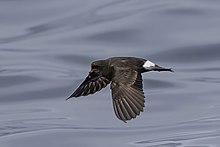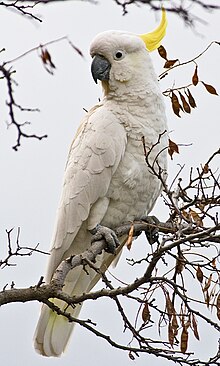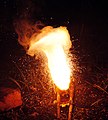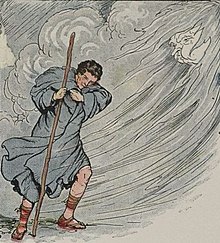Portal:Science
Science portal

Science is a rigorous, systematic endeavor that builds and organizes knowledge in the form of testable explanations and predictions about the world. Modern science is typically divided into three major branches: the natural sciences (e.g., physics, chemistry, and biology), which study the physical world; the social sciences (e.g., economics, psychology, and sociology), which study individuals and societies; and the formal sciences (e.g., logic, mathematics, and theoretical computer science), which study formal systems, governed by axioms and rules. There is disagreement whether the formal sciences are science disciplines, as they do not rely on empirical evidence. Applied sciences are disciplines that use scientific knowledge for practical purposes, such as in engineering and medicine. (Full article...)
Featured article -
The European storm petrel (Hydrobates pelagicus), also known as British storm petrel, or just storm petrel, is a species of seabird in the northern storm petrel family, Hydrobatidae. The small, square-tailed bird is entirely black except for a broad, white rump and a white band on the under wings, and it has a fluttering, bat-like flight. The large majority of the population breeds on islands off the northern coasts of Europe, with the greatest numbers in the Faroe Islands, United Kingdom, Ireland, and Iceland. The Mediterranean population is a separate subspecies whose strongholds are Filfla Island (Malta), Sicily, and the Balearic Islands. This subspecies is indiscernible at sea from its Atlantic relatives.
The storm petrel nests in crevices and burrows, sometimes shared with other seabirds or rabbits, and lays a single white egg, usually on bare soil. The adults share the lengthy incubation and both feed the chick, which is not normally brooded after the first week. This bird is strongly migratory, spending the Northern Hemisphere winter mainly off the coasts of South Africa and Namibia, with some birds stopping in the seas adjoining West Africa, and a few remaining near their Mediterranean breeding islands. This petrel is strictly oceanic outside the breeding season. It feeds on small fish, squid, and zooplankton, while pattering on the sea's surface, and can find oily, edible items by smell. The food is converted in the bird's stomach to an oily orange liquid, which is regurgitated when the chick is fed. Although usually silent at sea, the storm petrel has a chattering call given by both members of a pair in their courtship flight. The male has a purring song given from the breeding chamber. (Full article...)
Tumbler Ridge is a planned community with the housing and infrastructure construct built simultaneously in 1981 by the provincial government to service the coal industry as part of the British Columbia Resources Investment Corporation's Northeast Coal Development. In 1981, a consortium of Japanese steel mills agreed to purchase 100 million tonnes of coal over 15 years for US$7.5 billion from two mining companies, Denison Mines Inc. and the Teck Corporation, who were to operate the Quintette mine and the Bullmoose mine respectively. Declining global coal prices after 1981, and weakening Asian markets in the late 1990s, made the town's future uncertain and kept it from achieving its projected population of 10,000 people. The uncertainty dissuaded investment and kept the economy from diversifying. When price reductions were forced onto the mines, the Quintette mine was closed in 2000 production and the town lost about half its population. Coal prices began to rise after the turn of the century, leading to the opening of the Peace River Coal Trend mine by Northern Energy & Mining Inc. (now owned by Anglo American Met Coal) and the Wolverine Mine, originally owned by Western Canadian Coal, which was purchased by Walter Energy in 2010. Walter went bankrupt in 2015, and their Canadian assets—including the Wolverine Mine—were purchased by Conuma Coal in 2016. (Full article...)
A cockatoo is any of the 21 species of parrots belonging to the family Cacatuidae, the only family in the superfamily Cacatuoidea. Along with the Psittacoidea (true parrots) and the Strigopoidea (large New Zealand parrots), they make up the order Psittaciformes. The family has a mainly Australasian distribution, ranging from the Philippines and the eastern Indonesian islands of Wallacea to New Guinea, the Solomon Islands and Australia.
Cockatoos are recognisable by the prominent crests and curved bills. Their plumage is generally less colourful than that of other parrots, being mainly white, grey or black and often with coloured features in the crest, cheeks or tail. On average they are larger than other parrots; however, the cockatiel, the smallest cockatoo species, is a small bird. The phylogenetic position of the cockatiel remains unresolved, except that it is one of the earliest offshoots of the cockatoo lineage. The remaining species are in two main clades. The five large black-coloured cockatoos of the genus Calyptorhynchus form one branch. The second and larger branch is formed by the genus Cacatua, comprising 11 species of white-plumaged cockatoos and four monotypic genera that branched off earlier; namely the pink and white pink cockatoo, the pink and grey galah, the mainly grey gang-gang cockatoo and the large black-plumaged palm cockatoo. (Full article...)
The site had been badly damaged by ploughing by the time of Drewett's excavation, which limited his ability to draw conclusions from finds in the ploughsoil. Drewett mapped what appeared to be ditches, banks, and causeways before beginning to dig, and then cleared about half the site down to the chalk, confirming the location of the ditches and causeways. The majority of Drewett's finds came from the ditches, including about 7,000 worked flints, nearly 300 sherds of pottery, a human burial, other human bone, and animal remains. Most of the pottery was identified as Neolithic, and radiocarbon dating of charcoal found in one of the ditches confirmed that the enclosure dated to the Neolithic. A reanalysis of the radiocarbon dates in 2011, along with further radiocarbon dates from the human remains, concluded that the enclosure was constructed in the mid-fourth millennium BC. Further ploughing after the 1976 excavation led to the complete destruction of the site, in Drewett's opinion. The site was designated a scheduled monument in 1954. (Full article...)
Diodorus is a genus of silesaurid dinosauromorph (member of a clade that includes the dinosaurs) that lived during the Late Triassic in what is now Morocco. Fossils were discovered in the Timezgadiouine Formation of the Argana Basin, and were used to name the new genus and species Diodorus scytobrachion. The genus name honors the mythological king Diodorus and the ancient historian Diodorus Siculus; the specific name is ancient Greek for 'leathery arm' and also honors the mythographer Dionysius Scytobrachion. The holotype specimen is a partial dentary bone (front of the lower jaw), and assigned specimens include isolated teeth, two humeri (upper arm bones), a metatarsal (foot bone), and femur (thigh bone).
Diodorus is estimated to have been up to 2.3 m (7.5 ft) long, and features thought to be shared by most silesaurs include a beak-like front of the lower jaw, leaf-shaped teeth, long limbs, and a quadrupedal posture. Diodorus differs from other silesaurids in having forward-tilted teeth that decrease in size towards the front of the jaw, and in having a distinct ridge on the side of the jaw running parallel to the tooth socket margin. The Meckelian groove is distinct in that it expands in height towards the back, and the dentary is distinguished by being bowed at the underside. The femur measures 92 mm (3.6 in) in length and the femoral head has a rather straight front edge instead of rounded like in most other archosaurs. As in other silesaurids, but unlike all other archosaurs, there is a distinct notch below the femur's head. (Full article...)
Pancreatic cancer arises when cells in the pancreas, a glandular organ behind the stomach, begin to multiply out of control and form a mass. These cancerous cells have the ability to invade other parts of the body. A number of types of pancreatic cancer are known.
The most common, pancreatic adenocarcinoma, accounts for about 90% of cases, and the term "pancreatic cancer" is sometimes used to refer only to that type. These adenocarcinomas start within the part of the pancreas that makes digestive enzymes. Several other types of cancer, which collectively represent the majority of the non-adenocarcinomas, can also arise from these cells. (Full article...)
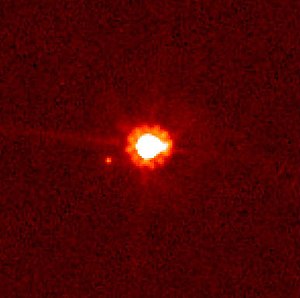
The scattered disc (or scattered disk) is a distant circumstellar disc in the Solar System that is sparsely populated by icy small Solar System bodies, which are a subset of the broader family of trans-Neptunian objects. The scattered-disc objects (SDOs) have orbital eccentricities ranging as high as 0.8, inclinations as high as 40°, and perihelia greater than 30 astronomical units (4.5×109 km; 2.8×109 mi). These extreme orbits are thought to be the result of gravitational "scattering" by the gas giants, and the objects continue to be subject to perturbation by the planet Neptune.
Although the closest scattered-disc objects approach the Sun at about 30–35 AU, their orbits can extend well beyond 100 AU. This makes scattered objects among the coldest and most distant objects in the Solar System. The innermost portion of the scattered disc overlaps with a torus-shaped region of orbiting objects traditionally called the Kuiper belt, but its outer limits reach much farther away from the Sun and farther above and below the ecliptic than the Kuiper belt proper. (Full article...)
The cutthroat trout (Oncorhynchus clarkii) is a fish species of the family Salmonidae native to cold-water tributaries of the Pacific Ocean, Rocky Mountains, and Great Basin in North America. As a member of the genus Oncorhynchus, it is one of the Pacific trout, a group that includes the widely distributed rainbow trout. Cutthroat trout are popular gamefish, especially among anglers who enjoy fly fishing. The common name "cutthroat" refers to the distinctive red coloration on the underside of the lower jaw. The specific name clarkii was given to honor explorer William Clark, coleader of the Lewis and Clark Expedition.
Cutthroat trout usually inhabit and spawn in small to moderately large, clear, well-oxygenated, shallow rivers with gravel bottoms. They reproduce in clear, cold, moderately deep lakes. They are native to the alluvial or freestone streams that are typical tributaries of the rivers of the Pacific Basin, Great Basin and Rocky Mountains. Cutthroat trout spawn in the spring and may inadvertently but naturally hybridize with rainbow trout, producing fertile cutbows. Some populations of the coastal cutthroat trout (O. c. clarkii) are semi-anadromous. (Full article...)

ZETA, short for Zero Energy Thermonuclear Assembly, was a major experiment in the early history of fusion power research. Based on the pinch plasma confinement technique, and built at the Atomic Energy Research Establishment in the United Kingdom, ZETA was larger and more powerful than any fusion machine in the world at that time. Its goal was to produce large numbers of fusion reactions, although it was not large enough to produce net energy.
ZETA went into operation in August 1957 and by the end of the month it was giving off bursts of about a million neutrons per pulse. Measurements suggested the fuel was reaching between 1 and 5 million kelvins, a temperature that would produce nuclear fusion reactions, explaining the quantities of neutrons being seen. Early results were leaked to the press in September 1957, and the following January an extensive review was released. Front-page articles in newspapers around the world announced it as a breakthrough towards unlimited energy, a scientific advance for Britain greater than the recently launched Sputnik had been for the Soviet Union. (Full article...)
Freedom Planet is a 2014 platform game developed and published by American video game designer Sabrina DiDuro, for her studio GalaxyTrail. The player controls one of three anthropomorphic animal protagonists: the dragon girl Lilac, the wildcat Carol, or the basset hound Milla. Aided by a duck-like alien named Torque, the girls attempt to defeat the evil Lord Brevon, who plans to steal the Kingdom Stone and conquer the galaxy. While the game focuses on fast-paced platforming, its levels are interspersed with slower action scenes.
DiDuro first began developing Freedom Planet as a Sonic the Hedgehog fangame using characters created by DeviantArt user Ziyo Ling for its main cast. Early into development, she lost interest in creating a derivative work and reconceived the project as her own intellectual property. Sash Lilac, originally a hedgehog, became a dragon; antagonist Doctor Eggman was replaced by Lord Brevon with his eyebrows resembling Doctor Eggman's mustache; and the Sonic series' ring-based health system was abandoned. Further changes were suggested by fans and incorporated throughout development. Freedom Planet was developed in Denmark and the United States, with its art direction carrying East Asian influences, such as medieval Chinese art inspiring its background visuals. (Full article...)

The Brown Dog affair was a political controversy about vivisection that raged in Britain from 1903 until 1910. It involved the infiltration of University of London medical lectures by Swedish feminists, battles between medical students and the police, police protection for the statue of a dog, a libel trial at the Royal Courts of Justice, and the establishment of a Royal Commission to investigate the use of animals in experiments. The affair became a cause célèbre that divided the country.
The controversy was triggered by allegations that, in February 1903, William Bayliss of the Department of Physiology at University College London performed an illegal vivisection, before an audience of 60 medical students, on a brown terrier dog—adequately anaesthetized, according to Bayliss and his team; conscious and struggling, according to the Swedish activists. The procedure was condemned as cruel and unlawful by the National Anti-Vivisection Society. Outraged by the assault on his reputation, Bayliss, whose research on dogs led to the discovery of hormones, sued for libel and won. (Full article...)

Bryce Canyon National Park (/braɪs/) is an American national park located in southwestern Utah. The major feature of the park is Bryce Canyon, which despite its name, is not a canyon, but a collection of giant natural amphitheaters along the eastern side of the Paunsaugunt Plateau. Bryce is distinctive due to geological structures called hoodoos, formed by frost weathering and stream erosion of the river and lake bed sedimentary rock. The red, orange, and white colors of the rocks provide spectacular views for park visitors. Bryce Canyon National Park is much smaller and sits at a much higher elevation than nearby Zion National Park. The rim at Bryce varies from 8,000 to 9,000 feet (2,400 to 2,700 m).
The Bryce Canyon area was settled by Mormon pioneers in the 1850s and was named after Ebenezer Bryce, who homesteaded in the area in 1874. The area around Bryce Canyon was originally designated as a national monument by President Warren G. Harding in 1923 and was redesignated as a national park by Congress in 1928. The park covers 35,835 acres (55.992 sq mi; 14,502 ha; 145.02 km2) and receives substantially fewer visitors than Zion National Park (nearly 4.3 million in 2016) or Grand Canyon National Park (almost 6 million in 2016), largely due to Bryce's more remote location. In 2018, Bryce Canyon received 2,679,478 recreational visitors, an increase of 107,794 visitors from the prior year. (Full article...)
Apollo 10 (May 18–26, 1969) was the fourth human spaceflight in the United States' Apollo program and the second to orbit the Moon. NASA, the mission's operator, described it as a "dress rehearsal" for the first Moon landing (Apollo 11, two months later). It was designated an "F" mission, intended to test all spacecraft components and procedures short of actual descent and landing.
After the spacecraft reached lunar orbit, astronaut John Young remained in the Command and Service Module (CSM) while astronauts Thomas Stafford and Gene Cernan flew the Apollo Lunar Module (LM) to within 14.4 kilometers (7.8 nmi) of the lunar surface, the point at which powered descent for landing would begin on a landing mission. After four orbits they rejoined Young in the CSM and, after the CSM completed its 31st orbit of the Moon, they returned safely to Earth. (Full article...)
Featured pictures
Vital articles

Did you know...
- ... that after Ursula K. Le Guin published her collection The Wind's Twelve Quarters, a reviewer called her the "ideal science fiction writer for readers who ordinarily dislike science fiction"?
- ... that at the age of 14, Jenny Suo conducted a science experiment that ultimately led to GlaxoSmithKline pleading guilty to breaching consumer protection laws?
- ... that Sarah Zettel wrote her first short story at the age of 20 and it was published in Analog Science Fiction and Fact five years later?
- ... that the best novel of American science fiction author Garrett Smith did not appear as a stand-alone book until over 60 years after his death?
- ... that Margareth Rago seeks to establish a methodology for what she calls "feminist science"?
- ... that Brian Stableford blamed the cancellation of the follow-up to his 2006 book Science Fact and Science Fiction: An Encyclopedia on the availability of information online?
Get involved
| This portal needs to be updated. Please help update this portal to reflect recent events or newly available information. Relevant discussion may be found on the talk page. |

|

|
Science News
- 17 April 2024 –
- Scientists announce that they have identified fossil remains of the Ichthyotitan, the largest marine reptile currently known, in the Westbury Formation in England. (NOS)
- 16 April 2024 –
- European Space Agency scientists announce the discovery of Gaia BH3, the second-largest known black hole in the Milky Way. (NOS) (ESA)
- 4 April 2024 – 2020–2024 H5N1 outbreak
- Scientists from the Federation University Australia report that thousands of Adélie penguins have been found dead in Antarctica amid an increase in bird flu cases among wild bird populations. (Reuters)
- 4 April 2024 –
- Researchers at the Dark Energy Spectroscopic Instrument in Arizona, United States, release the largest 3D map of the universe featuring more than six million galaxies. Using this map, researchers are able to measure the acceleration of the expansion rate of the universe with unprecedented accuracy, detecting hints that the rate of expansion has been increasing over time. (The Guardian) (Berkeley Lab)
- 12 March 2024 –
- A scientific expedition to the Bounty Trough off the coast of New Zealand reports the discovery of more than one hundred new species. (The New York Times)
- 28 February 2024 –
- The Canadian government releases its report into the high-profile firings of two scientists from the National Microbiology Laboratory in Winnipeg, Manitoba, in 2021, stating that the pair worked closely and covertly with the Chinese government. (National Post)



